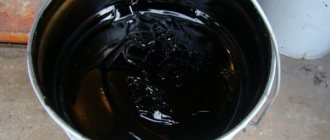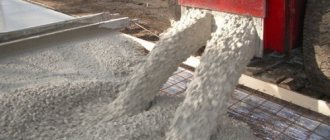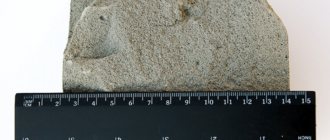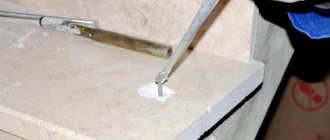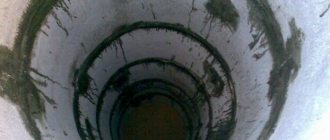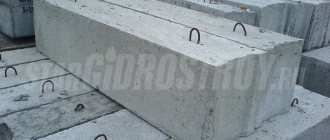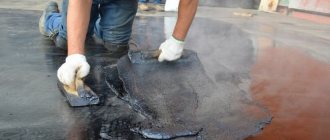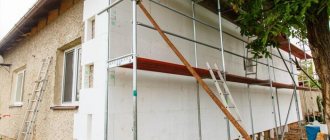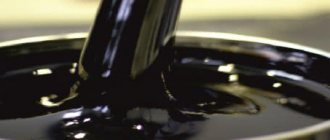Adhesive and weld-on coatings for waterproofing concrete surfaces
Waterproofing concrete using roll coatings is one of the most traditional. Materials are manufactured based on bitumen. Old generation coatings had a significant drawback - they were very fragile, which created difficulties both during installation and during further operation. Now polymers are added to the bitumen used for the manufacture of roll waterproofing, which significantly improves the characteristics of the material.
Roll waterproofing based on bitumen is divided according to the installation principle into:
- Pasting. To install waterproofing, the surface is first coated with bitumen mastic. Next, lay the waterproofing itself and carefully level it. The joints are overlapped and glued together with mastic. Waterproofing can be done in several layers, alternating mastic and rolled material.
- Welded. This waterproofing is bonded to the coating using burners. The material is rolled out over the surface and heated. The mastic layer melts and glues the canvas to the base. The joints are also overlapped.
Sealant for concrete
Sealant is used when it is necessary to waterproof small cracks or seams in concrete. There are a large number of different sealants that differ in the main ingredient: rubber, bitumen, silicate, silicone, acrylic, polyurethane, etc.
Three of them are the most popular:
- Acrylic sealant. Made from acrylic. By and large, it's more of a putty. It does not waterproof very well, but it can fill large spaces, levels well and is beautifully painted after drying;
- Polyurethane sealant. It quickly bonds to the surface and, after polymerization and drying, has high strength. It has proven itself to be excellent for sealing seams and joints between slabs. Paint can be applied over the dried polyurethane sealant;
- Silicone sealant. The most commonly used and popular. Best protects against moisture and dampness. Can be used on different surfaces as it has high adhesion. The downside is its insusceptibility to painting - paint simply does not adhere to dried silicone sealant. But there are already tinted silicone sealants.
Silicone sealants can be acidic or neutral. For work on concrete, exclusively neutral silicone sealants are used, since acids, when reacting with substances from concrete, can destroy both the concrete itself and the sealant.
Advantages and disadvantages of using material for waterproofing
Before choosing waterproofing with bitumen, you should carefully study what the pros and cons of its use are. You should start with the positive aspects, since most often they are fundamental when making a decision:
- Bitumen exhibits the properties of an ideal waterproofing substance, since it repels moisture from the surface and prevents its capillary movement.
- The technological process of using bitumen in construction, with the use of waterproofing, allows you to exclude the line of payment for the work of a specialist from the financial plan, since it is not so difficult that you cannot handle it yourself. Therefore, you just have to carefully study the theoretical side of the issue and carefully calculate the bitumen consumption for waterproofing.
- The use of this building material does not create seams at the joint, so the risk of leaks is reduced to a minimum.
- Bitumen waterproofing is relevant for any latitude and remains effective for various weather conditions, since it has high frost resistance and is also not susceptible to the destructive effects of ultraviolet rays.
- The use of bitumen mastics qualitatively protects the coating from biological hazards: fungi and mold.
Despite the large number of positive aspects, pouring bitumen also has negative qualities that can make you think about whether to use this method of waterproofing or not.
- The main disadvantage of using bitumen mastic is the impossibility of applying any masking layer.
- This building material, although practical, is visually quite rough. Therefore, we have to put a lot of effort into somehow ennobling it.
Waterproofing concrete with “liquid glass”
Liquid glass is a substance that is a mixture of sodium and potassium silicates. The composition of liquid glass is similar to stationery glue. The silicates that make up liquid glass react with concrete components and plug microcracks in layers close to the surface.
Liquid glass is a penetrating waterproofing material. Application is very simple - using a brush or roller. You can do the work yourself. But, it should be noted that the composition is fragile after drying, so such waterproofing requires protection from mechanical damage.
To increase the service life of buildings and to reduce the impact of moisture on them, waterproofing of concrete is necessary. A variety of materials can be used for this: concrete sealant; hydrophobic additives for concrete; mastic for concrete; welded or glued rolls. The main thing is that the waterproofing is selected appropriately, and the treatment is done professionally.
Rolled waterproofing materials these days are often replaced by modern coating mixtures, since concrete absorbs liquid solutions well. Mastics have a viscous plastic consistency, due to which they firmly bind to the base and form a single whole with it.
Purpose and application
The use of waterproofing mastic prevents premature destruction of structures in direct contact with water or exposed to aggressive factors. When operating foundations, roofs, basements, communications, underground garages, floors, and hydraulic structures, the following negative phenomena are possible:
- seepage of groundwater through micropores;
- cracking and shedding of material destroyed due to thermal expansion and precipitation;
- the appearance of cracks during shrinkage of buildings.
Bitumen and polymer waterproofing helps prevent water from penetrating into the concrete structure, creating a moisture-proof protective film on the surface. When choosing impregnation, take into account the following characteristics:
- water resistance to tearing (for basements and ground floors) and pressure (concrete experiences similar loads in pools and tanks);
- resistance to cracking under dynamic stresses;
- adhesion indicators;
- ease of use, can be applied to wet concrete;
- reliability, service life.
Advantages of bitumen mastic
Like all materials for waterproofing, bitumen mastic has special properties and has its own scope of application. In addition, the material has many advantages, the following properties are especially worth highlighting:
- High elasticity. This property allows for good adhesion between the foundation and the waterproofing material. Consequently, the base receives reliable protection from moisture penetration and further destruction.
- Due to the elasticity of the mastic, the protective layer remains intact even when the entire structure shrinks.
- Bituminous mastic for foundation waterproofing prevents the formation of corrosion centers and also prevents their development. This has a positive effect on the service life.
- The material contains elements that prevent the appearance of moldy areas and various fungi.
- Penetrating into the pores of the material, waterproofing fills the smallest cracks.
- The composition is easily and quickly applied to the surface, so it can be used for self-application. In this case, the main condition is not to leave areas on the surface of the foundation untreated.
- Bitumen mastic can be used as an adhesive layer when installing rolled waterproofing materials.
Overview of the main types of mastic
These materials are quite widely represented on the construction market. Read about other types of waterproofing here. Depending on the composition of the ingredients, there are two types of mastic for waterproofing.
1. Polymer acrylic.
It is intended for cold application, made by mixing polymers and emulsifiers with water. Eco-friendly, approved for treating interior spaces: kitchens, bathrooms, window gaps, swimming pools. Acrylic-polymer waterproofing of concrete withstands temperature fluctuations well: its volume does not change and the layers do not shift. The mixture fits well on previously prepared, leveled and cleaned substrates that are not damaged. Provides waterproofing and protection against steam and heat loss.
Mastic, made from petroleum products with various additives, is well known to consumers. It is a thick, dark paste applied to the concrete in a thin layer. After hardening, its density increases - due to this, the surface is sealed.
- crack resistance;
- service life 25-50 years;
- local or continuous waterproofing is possible;
- resistance to biological and chemical reagents;
- high speed of application and drying;
- low consumption per m2.
Types of foundation waterproofing
Depending on the characteristics of the building and soil analysis, one or another type of waterproofing is selected that is most suitable for a particular building. Depending on the direction and location of application of the protective layer, horizontal and vertical types of waterproofing are divided.
Horizontal
Horizontal waterproofing is applied to the base of the building, having previously cleaned the foundation. This can be done manually using improvised or mechanized means, as well as using a water-pressure method.
Laying roofing felt on the base of a building is one of the options for reliable waterproofing
You can begin work on horizontal waterproofing both before and after the construction of the foundation. Of course, it is easier to protect the base of the building before pouring the foundation.
A moisture penetration barrier can be created using a thick continuous polyethylene film, as well as using waterproofing material in rolls (for example, hydroglass insulation). To enhance waterproofing properties, you can use bitumen or mastic based on it.
There are still quite a lot of materials that are used for waterproofing the base of a building:
- hydroisol;
- stekloizol;
- glassine;
- technoelast;
- roofing felt;
- liquid rubber;
- Elon et al.
Vertical
All new buildings need vertical waterproofing; it can be done even if there are visible signs of damage to the old insulation.
Workers are using the fusing method to increase the service life of the building.
Work to protect the building from moisture should also be carried out before the start of operation of buildings for which it is unknown whether waterproofing measures have been carried out there.
Vertical waterproofing (as opposed to horizontal) is carried out on the external walls of the building.
A necessary step in vertical waterproofing is thorough cleaning of the walls from dust, dirt, rust and other negative changes in the foundation. The walls of the structure are exposed to a monolithic structure. If the building was previously covered with a waterproofing layer, but you are not sure of its functionality, then it is better to get rid of it and then apply a new one.
The materials for vertical waterproofing can be used the same as for the horizontal method.
Application technology
Select materials and equipment from the following list:
- tools for preliminary preparation of concrete - you can choose from a grinder, a sand blower, a jackhammer, a metal brush, or an industrial vacuum cleaner;
- devices for applying the composition - brushes, spatulas, sprayers, rollers with a fur attachment, squeegees (special wide spatulas);
- mixer or drill with a whisk attachment, solution container;
- covering material – polyethylene film or non-woven products;
- respirator or goggles, gloves, workwear.
Concrete is pretreated:
1. Organic deposits (mold) are removed using biocidal agents. The preparations are sprayed or applied with a brush in two doses with an interval of several hours. After a few hours, the solution is washed off, and the second layer is left until dry.
2. Treat the surface with fluates - means for removing salt deposits. First, the seams and walls in the affected areas are cleaned with a brush, then they are abundantly impregnated with an aqueous solution of fluate (1:1) in 2-3 stages. After a day, clean it again with a brush.
3. Carefully prime the base with primers using brushes or fur rollers. Depending on the components of the composition, humidity and temperature, the surface dries in 0.2-12 hours.
Waterproofing concrete with mastics
The technology depends on the design features.
1. Roof. Mastic is poured onto the base in 3-4 layers and spread with a brush or squeegee. To obtain insulation with a thickness of 2 cm, a total application thickness of about 4 mm is maintained. To reduce consumption, the mixture is sprayed airless using a special apparatus. Waterproofing alternates with reinforcing layers of fiberglass (each of them is thoroughly dried). The resulting protective “pie” is covered with reflective mastic.
2. Basements, foundations, tanks. Apply 2 layers onto the cleaned and primed base using spatulas. After each stage, dry for 1-24 hours. Insulation from protective boards is glued on top of the sticky surface.
3. Floor screed, interior spaces. The floor or walls are primed with an emulsion primer, water-emulsion (acrylic or bitumen-latex) mastic is applied in 2 layers with intermediate drying for 5 hours. The joints are sealed with self-adhesive tape or geotextile (embedded in the bottom layer of waterproofing).
External waterproofing is applied subject to the thermal conditions: the minimum ambient temperature is -10°C, and the working surface is from +5°C (for this it is dried and heated). At sub-zero temperatures, cold-applied solvent-based mastic should be heated to +15°C. For this purpose, it is kept in a heated room for at least a day. Cold water-based composition is not used at sub-zero temperatures: the minimum temperature for air is +5, for the working mixture – from +20°C.
Cost of mastic for concrete waterproofing
The specific consumption is indicated on the label (for example, 1.25 kg/m2): this is an average figure for different surfaces, excluding corners and joints, based on a layer thickness of 2 mm. For concrete, a multiplying factor of 1.08 is used. If the thickness is greater than the standard (say, by 20%), the consumption per square meter will increase in proportion to this increase (1.2 times). In our example, the amount of mastic per square meter will be: 1.25 x 1.08 x 1.2 = “” 1.62 kg/m2. For a four-layer roof covering with an area of 50 m2, you will need 1.62 x 50 = “” 85 kg of material.
When constructing a building or foundation, it is worth thinking about creating a protective layer on the foundation. It will provide structures with high moisture resistance, protect them from corrosion, as well as other destructive factors. Protection technology significantly extends the service life of a concrete floor. Mastic is used to ensure waterproofing of concrete. The product contains polymer materials, which gives good absorbent characteristics.
Mastic on concrete floor
Types of bitumen mastic
Types of mastic
Mastic based on bitumen can be of different types, it all depends on the composition of the material and the technology of its use. In this regard, the division is carried out according to the following criteria:
Application technology.
This process has two varieties:
- Hot application. The peculiarity of hot mastic is that before application it requires heating to a certain temperature. At the same time, there are mastics with high heat resistance that require maximum temperature to achieve working condition. This includes mastics used as adhesive for roll waterproofing. If bitumen-based mastic is used as an independent coating waterproofing of the foundation, then it heats up to a viscous state with slight heating. Experts do not recommend mixing types of mastics that have different temperature characteristics. Hot bitumen mastic for the foundation requires strict adherence to safety regulations and technological process. Therefore, it is best to invite a specialist to work with hot mastic.
- Cold mastic is applied without preliminary preparation, but requires thorough mixing before use. It is worth noting that applying a cold version of coating waterproofing at subzero temperatures requires some heating.
Dissolution options.
Depending on the components included in the composition, bitumen mastic can be water-soluble or made on the basis of organic solvents. Therefore, you can get a more liquid consistency by diluting with a liquid similar to the mastic base.
Number of components
Bitumen-based mastics for foundation waterproofing can vary in the number of components for preparing the mixture:
Mastic components
- One-component mastics are already ready for use. To work, you need to open the package, mix the mastic and apply it.
- To prepare two-component bitumen mastic, it is necessary to combine two components in compliance with certain proportions. Such mixtures harden quite quickly, so the composition must be prepared immediately before application. Two-component mastics can be stored for a long time in a closed container. In addition, they have high durability during operation.
Degree of hardening.
Bituminous mastic after application can be completely hardened or in a semi-solid state.
Component composition
Depending on the additional substances introduced into the composition, the following types of mastics can be found:
Compositions of bitumen mastic
- Bitumen-mineral. It contains chalk, cement or quartz additives. The content of these substances does not exceed 20%. In addition, such a mastic necessarily contains a plasticizer. The production technology of bitumen-mineral mastic allows the content of 5% of this substance. In cold mastic, lakoil can play the role of a plasticizer. This waterproofing composition does not harden in air and can withstand any load without damage. This allows the use of waterproofing material for buried areas of the base.
- Bitumen-rubber. Rubber powder or synthetic rubber is added to the composition of such material. These substances give elasticity to the material. Special mineral oil can be used as a plasticizer.
- Bitumen-rubber. This mixture has good viscosity, so the coating is dense and elastic, while perfectly protecting the foundation from moisture.
- Bitumen-polymer. This mastic is made on the basis of modified polymers. The absence of organic solvents allows the material to be used indoors.
- Bitumen-latex. Mastic made on the basis of a water emulsion with the addition of synthetic rubber.
- Bitumen-oil. This mixture can be used to waterproof buried parts of the base. To dilute the composition, you can use gasoline or white spirit.
- Bitumen primer. This material has a more liquid consistency than regular mastic. Depending on the base, it can be diluted with solvent or water. The main purpose is to prepare the surface for waterproofing work.
Bitumen waterproofing
Concrete, with its monolithic structure, is used longer than other conventional materials. Small cracks and pores are found in the concrete, allowing moisture access to the monolith. These small defects allow moisture to penetrate inside the metal frame of the monolith, and it, in turn, provides resistance to tearing and bending.
Moisture poses a great danger, since upon contact with metal fittings, corrosion processes occur. Considering that a concrete foundation can withstand high pressure, this leads to unpleasant problems: the risk of foundation rupture and subsidence increases. This situation leads to deformation of the building as a whole and the appearance of cracks.
Coating concrete surfaces with mysticism
To prevent troubles, measures should be taken to protect the concrete floor. Bituminous waterproofing copes effectively with this, which seals all pores and microcracks in the concrete structure. Typically this material is used in liquid form during construction work.
Pros and cons of bitumen waterproofing
The popularity of waterproofing mastic lies in a sufficient number of advantages and conveniences:
- When applying waterproofing there are no seams. Therefore, it leaves no chance for harmful factors to act on concrete.
- Easy to apply.
- Concrete structures can be coated with a brush, roller, or special equipment by spraying the material onto the surface.
Treating concrete surfaces by spraying has its advantages: it is evenly applied even in inaccessible places. Since the cost of mastic is affordable and working with it is not difficult, the waterproofing material is very popular.
The only disadvantage of mastic waterproofing is that it is protected from capillary moisture, and the structures are not protected from strong exposure to moisture.
Types and methods of applying waterproofing
There are two types of waterproofing: vertical, horizontal. With vertical insulation material is applied to walls and other surfaces. When horizontal, it is carried out on all bases of the building.
A layer of waterproofing is provided at the design stage of the building, since it determines the protection of the structure from moisture, which reduces the service life several times and can ruin the entire work, causing huge irreparable losses. To ensure complete waterproofing, long periods of time are required - the average figure is 15 days.
Horizontal bitumen waterproofing
Horizontal insulation is considered an effective method of protecting a structure from groundwater flows. In places where a lot of them accumulate, such a protection system is indispensable. When waterproofing is installed between the ground or the foundation of a structure, a kind of “cushion” is formed there, which prevents contact.
Attention! When a large amount of groundwater accumulates in areas where a building is being constructed (waterproofing cannot cope), then it is necessary to equip a drainage system at the stage of building the foundation.
Waterproofing materials
Mastic materials include bitumen - a mixture that is a waste product from oil refining with polymer additives. It protects the foundation and other structures.
The purpose of bitumen is to ensure the durability of the insulation of structures. Due to the bitumen content, the mastic is strong and elastic. The composition contains solvents. Mastic waterproofing material is divided into hot and cold.
Applying hot mastic
Hot waterproofing mastic is prepared immediately before applying it to the base and other parts of the structure. The big advantage of hot mastic is its fairly low cost compared to other types of waterproofing. In addition, it fully provides and performs a protective function. The main components contain a solvent that penetrates deeply into the concrete floor and foundation.
Cold type mastic
Cold mastic is a ready-to-use mass of material to which elements have been added during production. It has a fairly high cost. The advantage is that it is ready for use, it is not exposed to steam, and there is no swelling. To apply to the surface, it is enough to have a spatula.
Attention! Cold waterproofing bitumen mastic has a viscous consistency - this should be remembered before carrying out work.
The following bitumens are most often used to protect structures:
- solid;
- liquefied;
- bitumen-rubber;
- bitumen-polymer.
Waterproofing materials
The use of special materials made on the basis of bitumen makes it possible to isolate not only the foundation, but also other structures of the building or structure from moisture. In addition to the oil refining product bitumen, special polymer additives are added to the mastic.
The main function of such components is to give the mastic durability, the layer of ductility and strength created with its help, etc. In addition, solvents can be added to the mixture to give it special properties.
Today there are several types of mastics on the building materials market:
- Hot mastic, the main difference of which is that it should be prepared immediately before use on the construction site. The main advantage of hot mastic is its relatively low cost.
Hot mastic creates a moisture-resistant layer that perfectly protects any structure from dampness and corrosion.This mixture contains a solvent that has high penetrating ability. This property of the bitumen mixture ensures high adhesion of the mastic and the surface that it should protect from exposure to water.
- Cold mastic. It is more expensive than hot mastic, but it is less hassle because it is sold ready-made. The company has already added all the solvents and additives necessary to give the mixture the required properties.
Cold mastic is not exposed to water vapor, so the protective layer it forms on the surface does not swell over time.Cold mastic can be applied using hand tools, a spatula, or a sprayer, although it is worth paying attention to the viscosity of the mixture when choosing an application method.
Criterias of choice
Waterproofing material is classified according to a large number of characteristics. Properties and materials influence:
- Cement, polymers with minerals - dries quickly under certain conditions: low humidity, high temperature. When natural conditions are not suitable, drying takes a long time. The mastic becomes a moisture-resistant cover that still holds pressure.
- Minerals with epoxides are a toxic compound; the components impart greater elasticity and density, making them thinner.
- Bitumen-based products are popular in the field of insulation installation. The coating is durable, elastic, so its service life is long.
Mastic treated surface
Waterproofing mastic, which is based on bitumen, absorbs water, providing excellent bonding of the concrete floor. The layer is about 0.4 mm.
What is the consumption of mastic?
When performing waterproofing with mastic, determine the material consumption. How much is required for waterproofing work? This information can be found on the material label. It shows the recommended minimum for creating a waterproofing layer. Knowing such data, the amount of material can be easily calculated.
Volatile solvents have a significant share of mastic materials – up to 70%. This is the percentage of shrinkage after the job is completed. To determine the consumption of bitumen mastic per m 2, take into account the type of structure protected from moisture. For example, the consumption for a foundation is 24 kg, for roofing felt - 2 kg.
If hot mastic is used, the consumption will be slightly higher. In this case, the limit value does not exceed the maximum level.
To achieve the required layer thickness, mastic is applied to the concrete surface in several layers (2-3).
How to apply bitumen correctly
The process of treating the base with bitumen mastic is not too complicated, but it has some nuances that need to be taken into account - certain calculations and compliance with the sequence of actions.
In order to determine the consumption of bitumen per 1 m2, you must first determine its purpose . The amount of material required for construction work depends on this. When calculating the consumption of the composition for waterproofing, the area of the treated surface should be multiplied by two - this is exactly how many kilograms of bitumen will be needed for 1 m2.
If bitumen is used as a coating, its consumption per 1 m2 will be 2-3 kg with a coating thickness of 2-3 cm. The location of the base should also be taken into account - when applying the composition to a vertical surface, the consumption will be 2-3 times higher compared to a horizontal plane.
When planning to do the work yourself, you should familiarize yourself with the technical requirements, as well as the rules that will help you perform waterproofing efficiently. They are divided into main stages:
- preparatory work;
- priming ;
- application of material.
The bitumen composition is immediately ready for use, so you do not have to waste time dissolving and stirring it. It is only suitable for outdoor use!
Step-by-step application instructions:
- Wear special clothing made of thick fabric and construction goggles to protect against caustic fumes.
- If you use hot mastic for the foundation, it is recommended to wear a respirator - there should be no open areas on the body, even when it is too hot outside.
- The foundation is for cracks or pits; if they are present, cement mortar is mixed to seal existing defects.
- Using a grinder, sharp protrusions on the edges of the base are removed and the corners are rounded.
- The surface is cleaned of dust and dirt, then degreased and dried with a hair dryer to prevent swelling and peeling.
- The degree of humidity is checked - a piece of plastic film is placed on the base and left in one position for a day. If condensation does not appear underneath, the coating’s readiness for further work is confirmed.
- After the working surface has completely dried, it is treated with a primer composition .
- Before use, the material is mixed or shaken in a closed container until the material is completely homogeneous.
- The primer is applied in one layer using a roller, brush or a special spray gun in dry weather conditions and away from fire sources.
- When the soil composition has dried completely, you can begin to roll out the waterproofing material in a continuous layer so that there are no breaks. To do this, use a roller or a coarse brush; you can also use the pouring method.
- Each of the subsequent layers is applied after drying the previous one - long breaks are not needed here.
- In places where cracks may appear, the waterproofing is reinforced with fiberglass .
- At the end of the work the tools are inspected and cleaned using soap and water or a solvent.
The drying period may vary depending on seasonality, air humidity or the thickness of the insulator. Under normal conditions, drying occurs within 24 hours . Properly done waterproofing of the base will protect the building from leakage and the spread of fungus or mold. The durability of the house also depends on this.
Having familiarized yourself with the classification of bitumen mastic, its advantages and disadvantages, and application technology, you can safely begin the process of waterproofing a building with your own hands. The ability to independently calculate the required material will help you avoid unnecessary costs. Happy construction!
Features of working with surfaces
- Before use, the solution must be thoroughly mixed to obtain a homogeneous mass.
- If the solution thickens, add solvent.
- The frozen material is brought into a room where the air temperature is 15 degrees or more - the mastic is defrosted.
- The substrate should be thoroughly cleaned before applying the material.
- The quality of the insulation depends on the application of the material to the surface: when seams are formed, the structure will deteriorate.
- Metal structures are cleaned and coated with anti-corrosion material.
- If necessary, surfaces are primed.
- When carrying out waterproofing work with mastic, the presence of fire is not allowed.
- Work is carried out in special protective suits.
- Continuous air flow is also important.
